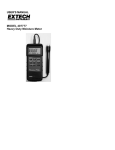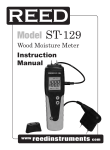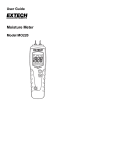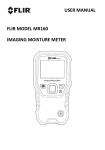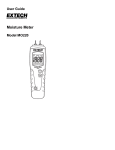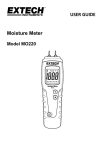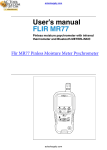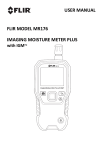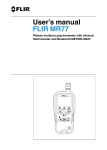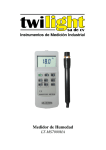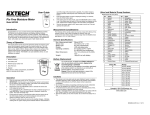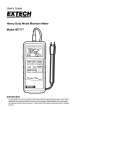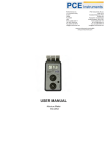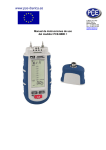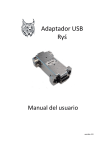Download Manual - Extech Instruments
Transcript
User's Guide Heavy Duty Wood Moisture Meter Model 407777 Introduction Congratulations on your purchase of the Extech 407777 Wood Moisture Meter. This meter measures the moisture content of wood as a percentage. Measurements are made using the supplied remote intrusive sensor. Careful use of this meter will provide years of reliable service. Warranty EXTECH INSTRUMENTS CORPORATION warrants this instrument to be free of defects in parts and workmanship for one year from date of shipment (a six month limited warranty applies on sensors and cables). If it should become necessary to return the instrument for service during or beyond the warranty period, contact the Customer Service Department at (781) 890-7440 ext. 210 for authorization or visit our website at www.extech.com (click on ‘Contact Extech’ and go to ‘Service Department’ to request an RA number). A Return Authorization (RA) number must be issued before any product is returned to Extech. The sender is responsible for shipping charges, freight, insurance and proper packaging to prevent damage in transit. This warranty does not apply to defects resulting from action of the user such as misuse, improper wiring, operation outside of specification, improper maintenance or repair, or unauthorized modification. Extech specifically disclaims any implied warranties or merchantability or fitness for a specific purpose and will not be liable for any direct, indirect, incidental or consequential damages. Extech's total liability is limited to repair or replacement of the product. The warranty set forth above is inclusive and no other warranty, whether written or oral, is expressed or implied. Specifications General Specifications Circuit Custom one-chip LSI microprocessor circuit Display Dual function 2000 count (0 to 1999) LCD display Measurement Range 9% to 30% Moisture Content Memory Table 9 memory groups for approx. 150 species of wood Data Hold Front panel push-button freezes displayed reading Sample Rate Approx. 0.8 seconds Sensor Structure Remote two-prong intrusive sensor Memory Record / Recall Records Maximum/Minimum readings for later recall Auto Power off Meter automatically shuts off after 10 minutes Data Output RS-232 PC serial interface for use with Model 407001 data acquisition software and interface cable kit Operating Temperature 32°F to 122°F (0°C to 50°C) Operating Humidity 90% Relative Humidity (max.) Power Supply 9V battery Power Current Approx. 5.8mA DC Weight 0.73 lbs (330g) (including batteries & probe) Size Main instrument: 7.1 x 2.8 x1.3" (180 x 72 x 32 mm) Accessories Spare pins (10) and protective rubber holster Probe: 0.9” (23mm) diameter x 6.54" (23mm) length Range Specifications Measurement Moisture content Range Resolution Accuracy 9 to 30% 0.1 % ± (4% + 5d) Temperature compensation: 32°F to 122°F (0°C to 50°C) 2 Model 407777 Version 2.2 Jan 04 Meter Description 1. Sensor input: Use caution when inserting the sensor. 2. PC interface jack: For use with Model 407001 software and interface cable kit 3. LCD Display: Displays moisture content, temperature compensation, units of measure, and function symbols 4. Push-buttons (see below): • Power: Turn meter on and off • Hold: Freeze displayed reading • Material: Select material group 1 through 9 (see Table in the Appendix) • Record: Track the highest (MAX) and lowest (MIN) readings • Recall: Review the MAX and MIN readings • Calibration and ‘+’: Used to calibrate the meter (refer to the calibration section) • Temperature Adjust: Used for temperature compensation function (refer to temperature compensation section in this manual) 5. Battery compartment (back): Remove the rubber protective holster to access the rear battery compartment 6. Protective holster: Rubber jacket insulates meter 7. Sensor pins: Replaceable sensor tips 8. Sensor handle: Hold the sensor by the handle when taking measurements 1 7 2 3 8 4 5 6 3 Model 407777 Version 2.2 Jan 04 Preparation 1. Insert the sensor into the sensor input jack on the meter top 2. Ensure that a fresh 9V battery is installed by powering the unit, observing that the LCD illuminates, and that the low battery indicator LBT is off. To access the rear battery compartment, the meter’s protective rubber jacket must be removed. 3. Remove the rubber pin protector from the sensor pin tips before use. 4. Note that this meter automatically turns off after 10 minutes to conserve battery life. To defeat this feature, press the RECORD key to access the data recording mode. In the recording mode, the automatic power off feature is disabled. For more on the recording mode, refer to the section ‘Maximum and Minimum Record and Recall’ later in this manual. Wood Moisture Measurements Wood moisture measurements for known wood type 1. Press the POWER button to turn on the meter. 2. Use the Material button to select a wood group (refer to the material list in the Appendix later in this manual). Select group 1 through 9 for general woods or Group 9 for chipboard. 3. Insert the sensor's test pins into the wood under test. 4. Insertion should be to at least a 0.08” (2mm) depth for highest accuracy. If this is not possible, carefully insert the test pins as far as possible without using undue force. 5. The meter display will now indicate moisture content in %. 6. If the moisture content is greater then 30% the display will indicate dashes at the top of the LCD display ( ). 7. If the moisture content is less than 9% the display will indicate dashes along the bottom of the LCD display ( _ _ _ _ _ ). Wood moisture measurements for unknown wood type Note that this method is used for reference only. Measurements of known wood types have a higher accuracy than measurements of unknown wood types. 1. Turn ON the meter. 2. Select Material Group 1 using the Material select button. 3. Insert the sensor's test pins into the material under test. 4. Insertion should be to at least a 0.08" (2mm) depth. However, if this is not possible, carefully insert the test pins as far as possible without using undue force. 5. The meter display will now indicate moisture content in %. 4 Model 407777 Version 2.2 Jan 04 Wallboard Moisture Measurements Unlike wood types which have known densities, wallboard does not. Consequently it is not possible to get an absolute moisture content reading. The following procedure can be used to make relative or comparative measurements of the moisture content in wallboard. 1. Turn ON the meter. 2. Select Material Group 1 by pressing the Material Select button. 3. Insert the sensor's test pins into a known dry area of wallboard. Insertion should be to at least a 0.08" (2mm) depth. The meter display will now indicate moisture content in %. Note this ‘dry’ reading. 4. Insert the sensor's test pins into the wallboard under test. Insertion should be to at least a 0.08" (2mm) depth. The meter display will now indicate moisture content in %. Note this ‘moist’ reading. 5. Compare the ‘dry’ wallboard reading with the ‘moist’ wallboard reading to determine the moisture content of the wallboard area under test. Temperature Compensation o o This meter is calibrated for use at ambient temperature: 68 F (20 C). When the temperature is above or below this value, manual temperature compensation should be performed to maintain meter measurement accuracy. Follow these steps: 1. Check that the RECORD function is not engaged (‘REC’ display icon is off). 2. Use the TEMPERATURE ADJUST buttons to increase (left button) or decrease (right o button) the temperature display to match the new temperature (in C). The temperature is adjustable in 1 degree steps. 3. The value will be stored after 4 seconds. Temperature compensation adjustments are not stored in memory when the meter is turned OFF however. Data Hold To freeze the LCD display reading, press the HOLD key. The 'DH' icon will appear on the LCD. Press the HOLD key again to return to normal operation (the 'H' hold icon will switch OFF). Maximum (MAX) and Minimum (MIN) Record and Recall To keep track of the highest (MAX) and lowest (MIN) measurements, follow the procedure below: 1. Press the RECORD button to begin tracking the highest and lowest readings. The REC display icon will appear on the LCD. 2. Press the RECALL key when it is desired to view the highest reading since the RECORD button was pressed. The MAX icon will appear on the display and the reading shown will be the highest reading encountered since the RECORD key was pressed. 3. Press the RECALL key again to view the lowest reading (MIN). 4. To exit this mode of operation, press the RECORD key again. The REC, MAX, and MIN icons will switch off. 5 Model 407777 Version 2.2 Jan 04 Battery Replacement When the low battery indicator LBT appears, the 9V battery should be replaced. 1. Remove the rubber protective holster that surrounds the meter. 2. Remove the battery compartment cover, located on the lower back of the meter, with a coin or a flathead screwdriver. 3. Replace the 9V battery. 4. Close the battery compartment and affix the protective holster. RS-232 PC Interface The Meter includes a PC interface for use with optional Data Acquisition Software and interface cable kit (Part Number 407001). Operational instructions for the interface and software are supplied with the optional interface kit. Calibration Calibration Verification 1. Ensure that the RECORD function is not engaged (REC icon is not on the LCD). 2. Select Material Group 1 using the Material Select button. 3. Press and hold both the CALIBRATION and the “+“ buttons. 4. The display will begin to count down from 5 to 1. 5. If the meter's existing calibration is correct, the LCD will display "good" 6. If the meter's existing calibration is incorrect, the LCD will display "Err". 7. If the calibration is incorrect follow the steps in the next section to recalibrate. Calibration Procedure 1. Remove the Meter's protective rubber holster. 2. Select Material Group 1 via the Material Select button. 3. Remove the rear battery compartment cover and locate the VR1 potentiometer that sits inside the battery compartment on the left side. 4. Press and hold the “+” Calibration button. 5. Adjust VR1 for a display of "18.0". 6 Model 407777 Version 2.2 Jan 04 Appendix - Table of Material Groups (alphabetized) with Group Numbers Abura 4 Erimado 5 2 Pine, Ponderosa 3 2 1 Meranti, Red (light or dark) Meranti, white Merbau Afara Afrormosia 1 6 Fir, Douglas Fir, Grand 2 2 1 3 Fir, Noble Gegu, Nohor Greenheart Guarea, Black 8 7 3 8 Missanda Muhuhi Muninga Musine 3 8 6 8 1 2 3 Guarea, White Gum, American Red Gum, Saligna 7 1 2 Musizi Myrtle, Tasmanian Niangon 8 1 3 Baguacu, Brazilian 5 Gum, Southern 2 Oak, Japanese 1 Balsa 1 Gum, Spotted 1 Oak, Tasmanian 3 Bange Wanga Basswood Bech, European Berlina Binvang Birch, European 1 6 3 2 4 8 Gurjun Hemlock, Western Hickory Hyedunani Iroko Ironbank 1 3 5 2 5 2 Oak, Turkey Oak, American Red Oak, American white Oak, European Obeche Odoko 4 1 1 1 6 4 Birch, Yellow 4 Jarrah 3 Okwen 2 Bisselon Bitterwood, Blackbutt Bosquiea 4 5 3 1 Jelutong Kapur Karri Kauri, New Zealand 3 1 1 4 Olive E. African Olivillo Opepe Padang 2 6 7 1 Boxwood, Maracaibo Cahoma Camphorwood, E. African Canarium, African Cedar, West Indian Cedar, Western Red 1 1 3 Kauri, Queensland Keruing Kuroka 8 5 1 Padauk, African Panga Panga Persimmon 5 1 6 Pine, Radiata Pine, Carribean, pitch Poplar, Black Pterygota, African Pyinkado Queensland Walnut Queensland Kauri Ramin Redwood, Baltic (Europe) Redwood, Californian Redwood, Baltic (Europe) Rosewood, Indian Santa Maria Sapele Seraya, Red Silky Oak, African Silky Oak, Australian Spruce, Norway (European) Spruce, Sitka Sterculia, Brown Stringybar, Yellow Stringybark, Messmate Sycamore Tallowwood Teak Afzelia Agba Amboyna Ash. European 4 8 6 1 Ash. Japanese Ash. American Ayan 2 8 3 Larch, European Larch, Japanese Larch, Western 3 3 5 5 2 3 Totara Turpentine Utile 4 3 8 Cherry, European 8 Lime 4 3 3 9 3 2 Coachwood Cordia, American light Cypress, E. African Danta Douglas Fir Elm, English Elm, Rock 6 5 1 3 2 4 4 Loliondo Mahogany, West Indian Mahogany, African Makore Mansonia Maple, Pacific Maple, rock Maple, Queensland Maple, Sugar Walnut Queensland Walnut, European Walnut, African 3 Chestnut Chipboard Pillarwood Pine, Maritime Pine, Nicaraguan Pitch Pine, American Long Leaf Pine, Corsican Pine, Yellow 3 4 2 1 1 3 2 Walnut, N. Guinea Walnut, American Wandoo Wawa Whitewood Yew 2 1 8 6 3 3 Elm, White 4 Matai 4 Pine, Hoop Pine, Kauri Pine, Huon Pine, Scots Pine, Lodgepole Pine, Sugar Pine, New Zealand, White Pine, Parana 8 2 2 1 1 2 1 7 3 1 1 1 4 3 8 6 1 2 1 1 7 3 3 3 3 3 3 1 3 3 5 1 5 3 8 2 Model 407777 Version 2.2 Jan 04 Calibration and Repair Services Extech offers repair and calibration services for the products we sell. Extech also provides NIST certification for most products. Call the Customer Service Department for information on calibration services available for this product. Extech recommends that annual calibrations be performed to verify meter performance and accuracy. Support Hotline (781) 890-7440 Tech support: Ext. 200; Email: [email protected] Repair/Returns: Ext. 210; Email: [email protected] Website: www.extech.com Copyright © 2004 Extech Instruments Corporation All rights reserved including the right of reproduction in whole or in part in any form. 8 Model 407777 Version 2.2 Jan 04








